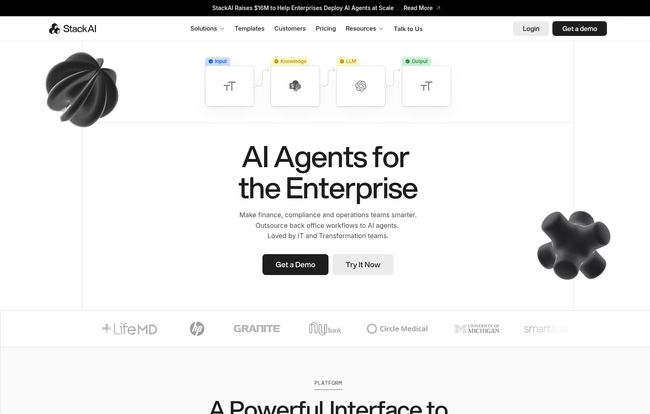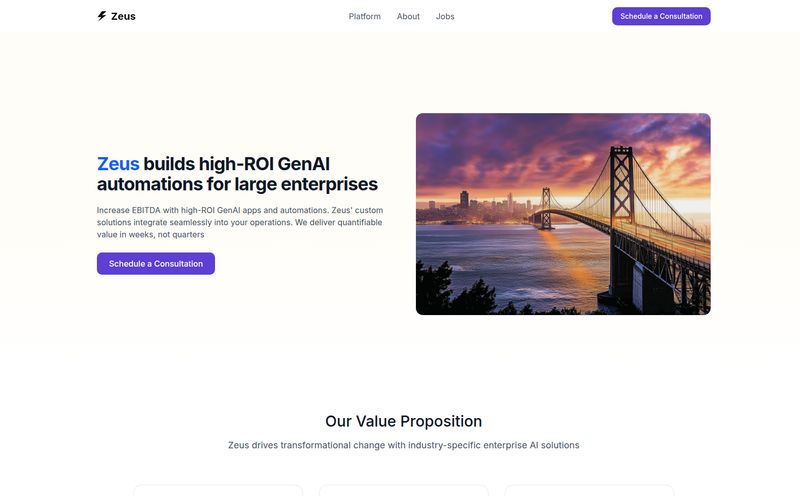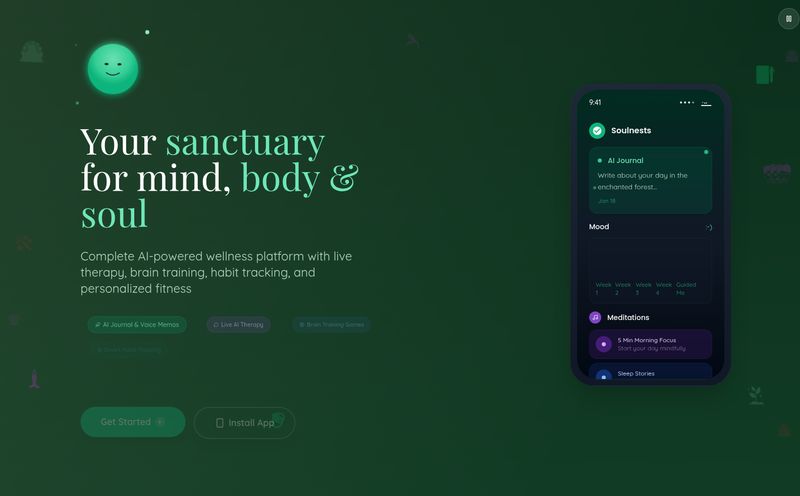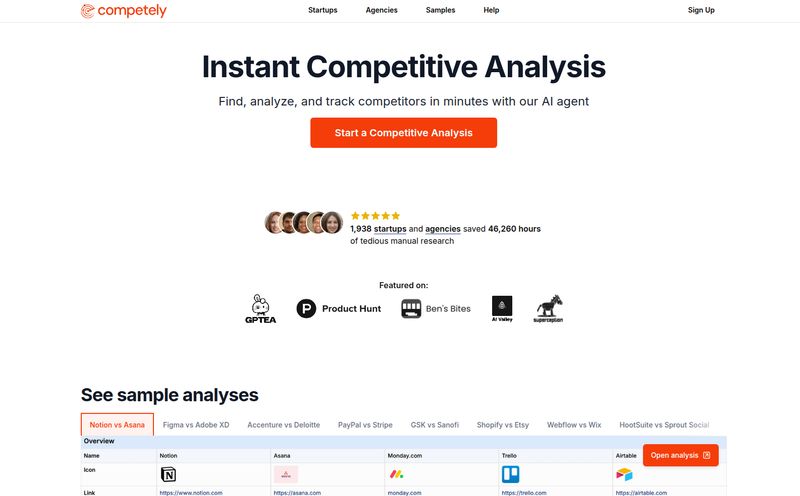It feels like you can’t scroll through LinkedIn or open a tech newsletter these days without being bombarded by AI. “Leverage AI,” “AI-Powered Solutions,” “The AI Revolution.” It’s enough to make your head spin. And for most of us, the immediate thought is, ‘Great, another thing I need a computer science degree to understand.’
For years, the promise of artificial intelligence felt locked away in an ivory tower, accessible only to developers with years of coding experience. But what if you could build powerful, custom AI agents with the same ease as putting together a PowerPoint presentation? That’s the promise of platforms like StackAI. And I’ve got to admit, as a guy who’s seen a lot of tools come and go, I was skeptical. But also… intrigued.
So I rolled up my sleeves and took a look. Is it just another tool with fancy marketing, or is there some real fire behind all that smoke? Let's get into it.
So, What Exactly is StackAI?
Let's cut through the jargon. StackAI is a no-code platform designed to help businesses build and deploy AI agents. Think of it like building with digital LEGOs. You get a whole box of cool, pre-made blocks—like different AI models (GPT-4, Claude), data inputs, and logic functions—and you just drag and drop them onto a canvas to create a workflow. You're not writing a single line of code. Not one.
Their whole mission is to connect your messy, unstructured data (think emails, support tickets, PDFs, customer feedback) to the power of generative AI. The goal? To automate those soul-crushing back-office tasks and free up your team to do, you know, work that actually requires a human brain.
The Core Features That Actually Matter
Any platform can throw a bunch of features on a pricing page. But after looking through StackAI, a few things really stood out to me as genuinely useful for businesses.
A True No-Code Experience
This is the big one. We've heard the term “low-code” for years, which often ends up meaning “you still need a developer to finish the job.” StackAI feels different. The visual, drag-and-drop interface is intuitive. If you can map out a process on a whiteboard, you can probably build it in StackAI. This is huge. It means your head of operations or your marketing manager—the people who actually understand the business processes—can build the solutions themselves. That's a game-changer for speed and efficiency.
Security Isn't an Afterthought
Here’s something that gets my attention as an SEO who works with all sorts of clients: security. Especially for enterprise-level businesses. A cool AI tool is useless if it’s going to leak customer data. StackAI clearly gets this. They're broadcasting their compliance with SOC 2 Type II, HIPAA, and GDPR. For anyone in finance, healthcare, or working with European customers, this isn't just a nice-to-have; it's a requirement. Building on a platform that has this baked in from teh start saves a world of headaches down the line.
Jumpstarting with Templates
Staring at a blank canvas can be intimidating. StackAI offers a bunch of pre-built templates for common use cases—things like AI-powered customer support, invoice processing, and lead enrichment. This is smart. It not only gets you started faster but also shows you what's possible, sparking ideas for other custom workflows you could build.

Visit Stack AI
Who Should Be Using StackAI?
On their site, they call out specific industries like Government, Insurance, Education, and Finance. And that makes perfect sense, given their focus on security and process automation. These are sectors drowning in paperwork and repetitive tasks.
But honestly, I see a much broader application. Imagine a marketing team building an agent that automatically analyzes customer reviews for sentiment and generates a weekly summary report. Or an HR department creating a workflow to screen resumes for specific qualifications. The real magic here is that it’s for any team that has a manual, data-heavy process they wish they could automate but lack the technical resources to do so.
Lets Talk About The Money and The StackAI Pricing
Alright, let's get to the question on everyone’s mind: what’s this going to cost? StackAI has a pretty straightforward two-tier pricing structure. Or, well, one and a half tiers.
The Free plan is your entry point. You get 100 runs per month, which is enough to build a few test projects and get a feel for the platform. It’s a great way to kick the tires without pulling out a credit card.
Then there's the Enterprise plan, which is listed as “Custom” pricing. This is where you get all the goodies: unlimited runs, on-premise deployment options, priority support, and all those critical security compliances. Now, I have a personal pet peeve with “Contact us for pricing” models. It can feel like you're about to walk into a car dealership blindfolded. That being said, for enterprise software with custom needs (like on-prem deployment), it’s a fairly standard practice. It just means smaller businesses or teams wanting a bit more than the free plan might feel stuck in the middle.
| Feature | Free Plan | Enterprise Plan |
|---|---|---|
| Price | $0 | Custom |
| Runs per month | 100 | Unlimited |
| Models (GPT-4, Claude, etc) | ✔ | ✔ |
| Priority Support | - | ✔ |
| Enterprise Security (SOC2, HIPAA) | - | ✔ |
The Good, The Bad, and The AI
No tool is perfect. After digging in, here’s my honest breakdown.
The biggest advantage is its accessibility. StackAI genuinely empowers non-technical people to build some seriously powerful stuff. It bridges the gap between a business need and a technical solution, and that's incredibly valuable. The time and cost savings are obvious, but the bigger win is the speed at which you can innovate. An idea you have on Monday could be a working prototype by Wednesday. Plus, the enterprise-grade security is a massive green flag.
On the other side of the coin, the limitations are mainly around the pricing structure. The free plan is more of a demo than a long-term solution for any active business. And the jump from free to a custom-quoted enterprise plan is a chasm. There isn’t a clear mid-tier option for a growing team that needs more than 100 runs but isn't quite at the Fortune 500 level. Some might also find that relying entirely on pre-built nodes could limit hyper-specific, edge-case customizations, but for 95% of back-office tasks, it's likely more than enough.
Real-World Proof from Real People
You don't have to just take my word for it. The social proof is pretty strong. I saw a quote from Doug Williams at Trilogy that caught my eye:
StackAI was paramount in easily building and testing AI pipelines that research, evaluate, and generate content. The no-code aspect is incredible and allows the team to focus on the intent and experience of the pipeline without the need to worry about the underlying services.”This hits the nail on the head. It’s about focusing on the what and the why, not the how. When you remove the coding barrier, you unlock a different kind of creativity and problem-solving. People from Y Combinator and LIFEMD are also backing it, which definitely adds a layer of credibility in the startup and health-tech worlds.
Visit Stack AI Frequently Asked Questions about StackAI
What is StackAI used for?
Primarily, StackAI is used to automate back-office processes and build custom AI applications without coding. Common examples include AI-driven customer support responses, invoice data extraction, content generation, and lead qualification.
Is StackAI really a no-code platform?
Yes. It operates on a visual, drag-and-drop interface where you connect different nodes (like AI models and data sources) to build a workflow. You don't need to write any code to build and deploy an application.
Is StackAI secure for sensitive business data?
The Enterprise plan is designed with high security in mind. It is compliant with SOC 2 Type II, HIPAA, and GDPR, making it suitable for businesses in regulated industries like healthcare and finance that handle sensitive information.
What's the catch with the free plan?
The main limitations are the number of runs (100 per month) and access to enterprise-level features like advanced security compliance and priority support. It's best used for testing and small personal projects.
How does this compare to a tool like Zapier?
While both are automation tools, they serve slightly different purposes. Zapier is fantastic for connecting App A to App B in a simple, linear fashion (e.g., “when I get a new email, add a row to Google Sheets”). StackAI is designed for building more complex, multi-step AI agents that can process unstructured data, use logic, and interact with multiple large language models in a single workflow.
Can I build something completely unique?
Absolutely. While the templates are a great starting point, the real power comes from combining the various nodes—inputs, AI models, logic, data loaders—in unique ways to solve your specific business problem. You're building from blocks, but the final creation is up to you.
Is StackAI the Right Move for Your Team?
So, here’s the bottom line. If you're a solo creator looking to automate a small task, the free plan is a fun playground. But where StackAI truly shines is in the enterprise space. If you're part of a larger team, especially one in a regulated industry, and you're constantly bottlenecked by manual data processing, this tool could be a revelation.
It successfully lowers the barrier to AI adoption, putting the power to innovate directly into the hands of the people who know the business best. While I wish there was a more transparent, mid-tier pricing plan, the platform itself is powerful, well-designed, and addresses a very real, very expensive problem for a lot of companies.
My advice? Sign up for the free account. Spend an afternoon trying to automate one annoying task. You might be surprised at how much you can build.
Reference and Sources



